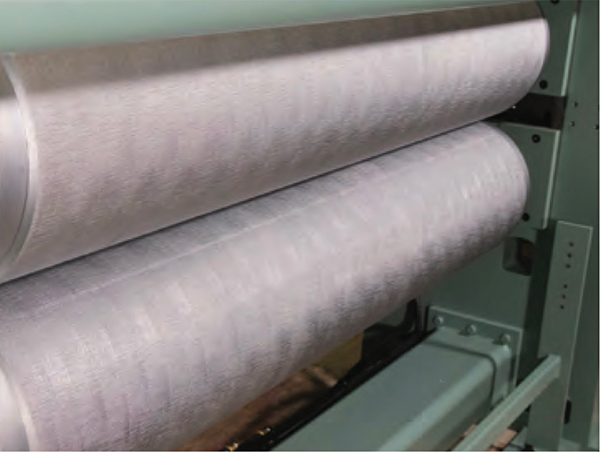Textured Rolls Create Attractive and Functional Substrates
- Published: October 09, 2023
By Mark Hines, Vice President – Sales & Marketing, Precision Roll Solutions
 Textured rolls, also known as coating rolls, metering rolls and anilox rolls, use patterns measured in lines per inch to deliver specific attributes and appearance characteristics to paper, film and foil substrates.
Textured rolls, also known as coating rolls, metering rolls and anilox rolls, use patterns measured in lines per inch to deliver specific attributes and appearance characteristics to paper, film and foil substrates.
After pattern development, manufacturing processes make the difference. Finalizing the embossing pattern is the first step in creating a consistent impression. Once a pattern is defined, high-quality embossing rollers are critical to bring embossing patterns to life. Engraving precise textures onto a roll surface requires understanding tolerance and application requirements. Choose a roll supplier that follows strict procedures that produce a consistent quality embossing pattern. It is also important to specify embossing equipment sturdy enough to withstand years of handling heavy embossing rolls.
While there are multiple techniques to engrave roll patterns, depending upon the final application, all of them start with a clean base roll.
Reconditioning rolls allow manufacturers and converters to maintain their sustainable manufacturing processes by recycling rolls. The refurbishment process involves turning down the used roll in order to start with a clean steel surface.
Once a base roll is established, electroplated copper is bonded to the steel surface, precision polished, engraved and finished with a layer of chrome to protect that surface. The following engraving processes are used for both new and reconditioned rolls.

Mechanical engraving – The oldest form of producing textured rolls uses a knurling tool to press into the copper surface and trans- fer the engraving pattern. Regular soft copper is used for mechanical engraving, with additives to make the copper surface harder if needed.
The mechanical engraving process works well if the pattern features one cell size to put down a uniform coating, such as glue, often used in various forms of packaging materials. Mechanically engraved rolls can also be used to put a pattern into a packaging substrate, such as a foil or film.
Electromechanical engraving – Hard copper is used for this technique, with a diamond stylus as the engraving source. The stylus vibrates and pokes holes into the copper in the shape of an inverted pyramid. The copper surface is highly polished, and the stylus provides more precision in the production of coating rolls and metering rolls.
Electromechanical engraving is the preferred technique for the packaging industry. A greyscale image is sent to a machine that automatically varies cell depths to print a simulated tonal range. Producers of laminate flooring, wood grain marble simulations, paneling, countertops and packaging foils use this type of textured roll.
Laser/chemical engraving – this process is reserved for specialized pattern embossing rolls that the first two methods can’t accomplish. A black lacquer is sprayed on top of the copper, and then the image is sent to the laser. The laser then removes just the paint coating to expose the copper beneath it. The roll then goes to an etching machine that uses ferric chloride acid on the copper. These rolls can be used to put images on labels or even individual pills for the pharmaceutical industry.
For decades, embossing rolls from Industrial Engraving, GB Embossing, and IR Engraving have benchmarked industries using rigid and flexible plastics, tissue/towel, napkins, fine paper, nonwovens, metals, packaging and more. Together as Precision Roll Solutions, these experienced teams manufacture embossing production rolls that impart uniform patterns and engineered applications to a wide spectrum of consumer products.
About the Author
Industry veteran Mark Hines has 30-plus years of experience serving the global paper, tissue converting and packaging industries. At Precision Roll Solutions, Mark brings together a vast network of precision roll and texture experts to solve customer challenges.




